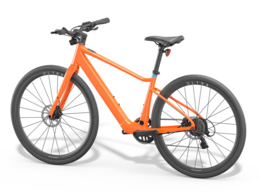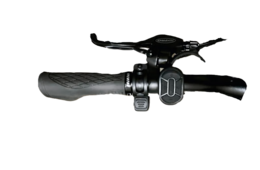E-bikes (electric-assisted bicycles), electric motorcycles and other small electric vehicles are becoming increasingly popular ways to get around Bellevue. Users of all ages should understand local rules—as well as the differences between e-bikes and electric motorcycles. Knowing the rules helps keep you and others safe on Bellevue’s streets, sidewalks and trails.
Is it an E-Bike or an Electric Motorcycle?
Washington state law outlines clear distinctions between traditional bicycles, e-bikes and electric motorcycles:
- Bicycles are powered solely by human pedaling (no motor).
- E-Bikes are bicycles that can be assisted by an electric motor and always have pedals that rotate. Some e-bikes only provide electric assistance when the rider is pedaling. Others can propel the e-bike using electric power alone. Legal e-bikes have a maximum speed of 20 mph (Class 1 and 2) or 28 mph (Class 3). An e-bike motor will never exceed 750 watts of power.
- Electric Motorcycles are powered solely by an electric motor and often don’t have moving pedals. They have foot pegs, other brackets or supports. Without moving pedals capable of propelling, the cycle is classified as a motorcycle.
Understanding the difference between an e-bike and an electric motorcycle is critical as many electric motorcycles are marketed as e-bikes but capable of much faster speeds than a traditional e-bike.
Electric Motorcycles are different
Electric motorcycles are classified as motor vehicles and subject to different requirements than e-bikes. They are more powerful, capable of reaching higher speeds and are not legal for children to operate.
Electric motorcycles are subject to age restrictions, licensing and registration requirements, and are limited to street use. Users whose “e-bike” meets the criteria of an electric motorcycle are required to follow all applicable motorcycle laws.
What Every Electric Motorcycle Rider Must Know:
- Definition and Features: Electric motorcycles are powered solely by an electric motor with no operable pedals, typically exceeding 750 watts, capable of speeds well above 28 mph, and include high-powered electric mopeds or electric motorbikes.
- Age and License Requirements: It is illegal for anyone under the age of 16 to operate an electric motorcycle. Operators must also hold a valid driver’s license with a motorcycle endorsement.
- Registration and Insurance: Electric motorcycles must be registered with the Department of Licensing (DOL) and display a license plate, similar to gas-powered motorcycles. Washington State law also requires these vehicles to be insured. Riding an unregistered or uninsured electric motorcycle on public streets is illegal.
- Equipment Requirements: Electric motorcycles are subject to the same equipment standards as traditional motorcycles. They must have functioning brakes, headlights, taillights, reflectors and mirrors. Riders are also required to wear a motorcycle-rated helmet when operating on public roads (see RCW 46.37.530).
- Where They Can (and Can’t) Go: As motor vehicles, electric motorcycles must follow all applicable motor vehicle laws. It is illegal to operate them on sidewalks, paths, bike lanes or multi-use trails anywhere in Washington. It is also illegal to drive them over or through any park in Bellevue (BCC 3.43.160). They are permitted only on roadways, just like any other motorcycle.
- Unregistered or Unlicensed Use: Under Bellevue City Code (BCC 11.55.020 and 11.55.030), electric motorcycles that lack proper registration, insurance, required equipment or a licensed operator are classified as non-highway vehicles or as wheeled all-terrain vehicles. These vehicles are prohibited on all state and city streets, sidewalks, bike lanes and shared-use paths.
E-Bike classifications and where you can ride
RCW 46.04.169 defines three e-bike classes in Washington State, each with specific rules on where they can operate and who may ride them. Since July 2018, all new e-bikes must display a label indicating their class, top assisted speed, and motor wattage. This label is typically located on the top tube or near the bottom bracket of the e-bike (RCW 46.37.690).
Below are the key differences between Class 1, Class 2, Class 3 e-bikes, in terms of speed, features, allowed usage, and rider requirements:
Class 1 E-Bike
- Definition & Features: Pedal-assist only — the motor provides help only while pedaling, cuts out at 20 mph, maximum 750W, no throttle.
- Where You Can Ride: Allowed on roads, bike lanes, and most trails where regular bikes are permitted (including mixed-use paths), unless otherwise posted. Allowed on sidewalks in Bellevue, with yield to pedestrians.
- Age Requirement: No minimum age set by state law (use recommended with parental supervision for minors).
Class 2 E-Bike
- Definition & Features: Throttle-capable, allowing propulsion without pedaling, motor up to 750W, top throttle speed of 20 mph, pedaling optional.
- Where You Can Ride: Same access as Class 1.
- Age Requirement: No minimum age set by state law (use with caution; not recommended for young children).
Class 3 E-Bike
- Definition & Features: Pedal-assist with speedometer; motor assists up to 28 mph, power up to 750W; no throttle for most, unless it is an e-bike that can switch classes (see below).
- Where You Can Ride: Allowed on roads and in bike lanes only. Not permitted on Bellevue’s trails, sidewalks or any paths; must be walked in those areas.
- Age Requirement: Riders must be at least 16 years old in Washington State.
Some e-bikes—including many popular entry-level models—can switch between Class 1, 2, and 3 through their software settings. Some manufacturers label these models as “Class 2/3” or “Class 1/3” to indicate their switchable modes, while others list only the default class even if it can be changed. Bellevue’s codes apply based on how your e-bike is configured when you ride, so changing modes can affect where users can ride, age limits, and other legal requirements. Always check your settings before you roll.
Rules of the road for E-Bikes
In Bellevue, e-bike riders must follow all standard bicycle rules of the road, along with additional e-bike specific regulations. When riding on a sidewalk or in a crosswalk, cyclists have the same rights and responsibilities as people walking (RCW 46.61.755). Always ride with safety and common sense.
Key rules for all bicycle and e-bike riders include:
- Yield to people walking: When riding on sidewalks or crosswalks, you must always yield to people walking or traveling with an assisted mobility device. Slow down, use a bell or your voice when passing, and give people walking the right of way.
- Obey Traffic Signs and Signals: People riding e-bikes must follow all traffic laws that apply to bicycles.
- Ride Where Comfortable and Only Where Allowed: Bicycles and Class 1 and 2 e-bikes may operate on paths, shoulders, general-purpose lanes, sidewalks, or bike lanes - whichever best suits the rider’s safety needs (RCW 46.61.770). Class 3 e-bikes, however, are not permitted on sidewalks or trails.
- Age Restrictions: To legally operate a Class 3 e-bike on public roads or trails in Washington, you must be at least 16 years old. There is no state-mandated minimum age for Class 1 or 2 e-bikes, but parents or guardians are responsible for ensuring minors ride safely.
- Helmet Use: Bellevue law requires all bicycle or e-bike riders to wear a helmet (BCC 11.60.090). Helmets must be securely fastened and properly fitted – they significantly reduce the risk of serious head injury in a crash.
- Light Requirements: When riding at night or in low-light conditions, state law requires using a white front headlight and a red rear taillight (RCW 46.61.780).
For more safety and etiquette tips on riding a bicycle or e‑bike in Bellevue, check out the Biking In Bellevue Tips For Safe Cycling flyer.
Enforcement of E-Bike and Electric Motorcycle laws
The Bellevue Police Department prioritizes public safety—and that includes safe operation of e-bikes and electric motorcycles. Officers will enforce traffic and device-specific laws to help protect everyone on the road. Individuals riding e-bikes or electric motorcycles recklessly, endangering others, or violating the rules outlined here may be stopped and could face penalties, including citations, fines, criminal charges, or tow impound where legal authority allows.
As a rider, it’s your responsibility to understand the rules, know what type of device you are riding and its classification, and operate it safely. The goal of enforcement is not to punish, but to prevent crashes and injuries. By riding lawfully and respectfully, you can avoid enforcement actions and contribute to a safer community.
Reporting unsafe or illegal use
If you witness someone operating an e-bike or electric motorcycle in an unsafe or unlawful manner, here’s what you can do:
- Emergencies or Dangerous Behavior in Progress: Call 911 immediately if you see dangerous or illegal behavior happening in real time—such as aggressive riding on a sidewalk that endangers people walking or any situation posing an immediate safety risk to public safety.
- Non-Emergencies/After the Fact: If the incident is no longer in progress or not an immediate threat, call the Bellevue Police non-emergency line at 425-577-5656 or file a report online. Provide as much detail as possible—what happened, when, and where—to help police track recurring issues and respond to community concerns.
For general questions about e-bike laws or to report ongoing issues, contact the Bellevue Police Department’s Traffic Unit using the non-emergency number above. You may also email: bellevuepd@bellevuewa.gov.
Whether you are a rider or a bystander, remember: these rules exist to keep everyone safe. Let’s all do our part to share the road and pathways responsibly.




